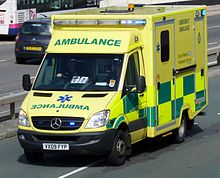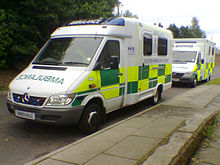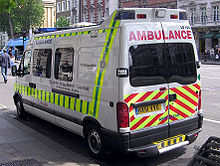- Emergency medical services in the United Kingdom
-
Emergency medical services in the United Kingdom provide immediate care to people with acute illness or injury, and are predominantly provided by the four publicly-funded health care systems: the National Health Service (for England), Health and Social Care in Northern Ireland, NHS Scotland and NHS Wales.[citation needed]
Contents
Role of the ambulance services
Public ambulance services across the UK are required by law to respond to four types of requests for care,[1] which are:
- Emergency calls (via the 999 or 112 system)
- Doctor's urgent admission requests
- High dependency and urgent inter-hospital transfers
- Major incidents
Ambulance trusts and services may also undertake non-urgent patient transport services on a commercial arrangement with their local hospital trusts or health boards, or in some cases on directly funded government contracts.[2] This is an area where an increasing amount of private firms are taking business away from the trusts.
Emergency ambulance work in all NHS bodies and most voluntary and private firms is based on the guidance published by the Joint Royal Colleges of medicine Ambulance Liaison Committee (JRCALC).[citation needed]
Public ambulance services
England

Emergency medical services are provided through local ambulance services, known in England and Wales as trusts. Each service in England is specific to a one or more local authority areas, and so the country is divided across a number of ambulance services, in a similar way to the Police.
In England there are twelve ambulance 'Trusts', with boundaries generally following those of the regional government offices.[3]
The ambulance services across England have been increasingly busy, with a significant increase in calls in the last two decades,[3] as shown in the table below:
Year Emergency Calls Source 1994/5 2.61 million [3] 2004/5 5.62 million [3] 2006/7 6.3 million [4] Following consultation, on 1 July 2006, the number of ambulance trusts fell from 29 to 13.[3] The reduction can be seen as part of a trend dating back to 1974, when local authorities ceased to be providers of ambulance services. This round of reductions in the number of trusts originated in the June 2005 report "Taking healthcare to the Patient", authored by Peter Bradley, Chief Executive of the London Ambulance Service, for the Department of Health.[5]
Most of the new Trusts follow government office regional boundaries, exceptions to this are the Isle of Wight (where provision will remain with the Island's Primary Care Trust), and South East and South West England which are both split into two Trusts. This has led to a number of old trusts ceasing to exist. Staffordshire ambulance trust had a temporary reprieve, but became part of the West Midlands ambulance trust on 1 October 2007. The new Trust structure is as follows:
Scotland
The Scottish Ambulance Service is a Special Health Board funded directly by the Health Department of the Scottish Government.[7] Until 1974, ambulance cover in Scotland was originally provided by a combination of the British Red Cross and St Andrews Ambulance.[8] In financial year 2008–2009, the service employed 3,797 staff across five divisions and attended to 599,052 accident and emergency incidents.
Complementing and working alongside the Scottish Ambulance Service is the Emergency Medical Retrieval Service.[9] This unique airborne medical initiative is based at Glasgow City Heliport and, staffed by consultants, uses various air assets to provide patients in remote and rural areas with rapid access to the skills of a consultant in emergency or intensive care medicine as well as facilitating transfers to larger, better equipped city hospitals. The team respond to calls 24 hours a day, utilising both helicopters and fixed-wing aircraft.
Scotland has Britain's only publicly funded Air Ambulance service, consisting of two Eurocopter EC 135 Helicopters (based in Glasgow & Inverness) and two Beechcraft B200C King Air fixed-wing aircraft (based at Glasgow & Aberdeen). In 2008/09, the air wing flew 3,797 air ambulance missions.[10]
The national headquarters of the Scottish Ambulance Service are in Edinburgh and there are five divisions within the Service, namely:
Scottish Ambulance Service Divisions Division Covering Area in Square Miles North Highlands, Western Isles, Grampian, Orkney, Shetland [11] 15,607 East Central Fife, Forth Valley, Tayside [12] 4,421 West Central Greater Glasgow, Lanarkshire [13] 1,054 South East Edinburgh, Lothian and Borders [14] 2,457 South West Argyll, Argyll islands, Clyde islands, Ayrshire, Dumfries and Galloway [15] 6,670 Northern Ireland
The Northern Ireland Ambulance Service (NIAS) is the ambulance service that serves the whole of Northern Ireland, and was established in 1995 by parliamentary order.[16] As with other ambulance services in the United Kingdom, it does not charge its patients directly for its services, but instead receives funding through general taxation. It responds to medical emergencies in Northern Ireland with the 270 plus ambulances at its disposal. The Service employs approximately 1,044 staff based across 32 stations & sub-stations, four Control Centres and a Regional Training Centre.[16]
Wales
The Welsh Ambulance Service NHS Trust (also called Ymddiriedolaeth GIG Gwasanaethau Ambiwlans Cymru) was established on 1 April 1998, and has 2,500 staff providing ambulance and related services to the 2.9 million residents of Wales.[17]
Its headquarters is located at H.M.Stanley Hospital, St Asaph, Denbighshire and it is divided into three regions:[18]
- Central and West Region based at Ty Maes Y Gruffudd, Cefn Coed Hospital, Cockett, Swansea
- North Region based at H.M.Stanley Hospital, St Asaph, Denbighshire
- South-East Region based at Vantage Point House, Ty Coch Ind Est, Cwmbran
Uniquely in the UK, The Welsh Ambulance Services NHS Trust is also responsible for the provision of NHS Direct, a nurse led telephone healthcare service which is provided by a separate Trust in England and by NHS 24 in Scotland.
Measuring performance
The performance of every Ambulance Trust is measured by the government. Commonly called 'ORCON',[19] after the consultancy used to formulate them, they are more properly called NAPS - New Ambulance Performance Standards. The Government's targets are to reach 75% of Category A (life-threatening) calls - as decided by the computerised AMPDS (except the Berkshire Division of South Central Ambulance where CBD (Criterion Based Dispatch) is used) - within eight minutes. A number of initiatives have been introduced to assist meeting these targets, including Rapid Response Vehicles and Community First Responders.[citation needed] The target in Wales is set by the Welsh Assembly Government (WAG). Currently the WAG requires 65% of category A calls to be reached within 8 minutes.
Measuring performance and criticisms
The performance of the Ambulance service is measured by the government, as part of a system called 'ORCON'.[20] The Government's target is to reach 75% of Category A (life threatening) calls within eight minutes, as recorded by the computerised AMPDS. A number of initiatives have been introduced to assist meeting these targets, including Rapid Response Vehicles and Community First Responders.
The Scottish Ambulance Service was criticised in a case where a technician attended a call out within four minutes — well within the eight minute target — but not a paramedic who alone could administer certain cardiac drugs.[21]
Private ambulance services
Private ambulance services are becoming more common in the UK,[22] performing a number of roles, including providing medical cover at large events, either alongside, or instead of the voluntary sector providers. Some organisers use a private firm instead of a voluntary ambulance service because of wider availability during the week (sometimes difficult for a voluntary service to cover) or for a wider range of skills, such as provision of qualified paramedics.[citation needed]
The most common type of private ambulance provider is in the patient transport role, with many trusts and hospitals choosing to outsource this function to a private company, rather than use the NHS service, although the policy differs from trust to trust.
Some companies have been contracted to provide additional emergency crews and vehicles to supplement the core NHS staff at busy times, with a quarter of the UK ambulance trusts contracting private companies to front line work.[23]
Voluntary services
Ambulance services
The main voluntary ambulance providers are the British Red Cross and St. John Ambulance, which have been providing emergency medical cover in the UK for many years, including active service in both World Wars (pre-dating the existence of any government organised service), and along with St Andrews Ambulance (now St Andrews First Aid, which no longer provides an ambulance service) ran statutory ambulance services in the United Kingdom under contract to the government until a reorganisation in 1974.[8] The primary activity of both organisations in relation to ambulances, is the provision of covers at events as an extension of their first aid contract.
Depending on their agreement/s with their local ambulance service trust (known as a "Memorandum of Understanding" or MOU), they may treat and transport certain categories of patient to hospital, although for more serious incidents, such as cardiac arrest it is likely that they would be expected to summon the assistance of the statutory ambulance service.[citation needed]
Both organisations also provide "reserve" or "support" cover to some, though not all, of the ambulance trusts , dependent on the local MOU, where ambulance crews from one of the organisations (who are usually volunteers, but in some instances may be paid staff) will attend 999, GP Urgent or PTS calls on behalf of the ambulance trust, with the organisation receiving recompense from the trust. This service is most often called on during major incidents (e.g. the 7 July 2005 London bombings), when there is a high level of staff absence or when there is an unusually high call volume, although in some areas, voluntary crews are regularly used to supplement full time trust cover.
Both organisations have also provided cover for the public on the very rare occasions when unionised NHS ambulance trust staff have taken industrial action.[24]
BASICS
The British Association for Immediate Care coordinates voluntary schemes, and individual medical and allied health professionals, providing immediate care throughout the UK.[25] BASICS doctors, for example, may assist ambulance paramedics at the scenes of serious road accident or be on-hand at major sporting events.
Blood courier services
There is a network of charities, mainly in various Counties of England, which provide voluntary motorcycle couriers for the National Blood Service and hospitals.[26] An example is the Freewheelers EVS operating in Somerset and surrounding counties. They carry blue lights and sirens which can be used when transporting blood or human tissue for transplant. The first operational service of this kind in Scotland is likely to be provided in the Greater Glasgow & Clyde NHS region by Scottish Emergency Rider Volunteer Service or ScotsERVS towards the end of 2011.<[27]
See also
- Air Ambulances in the United Kingdom
- Ambulance station
- Blues and twos
- Emergency Medical Retrieval Service
- Emergency medical services
- Fire service in the United Kingdom
- Former UK Ambulance Services
- HSE National Ambulance Service (Republic of Ireland)
- NHS trust
References
- ^ "Ambulance Service Definition". http://www.nhsdirect.nhs.uk/articles/article.aspx?articleId=529§ionId=21958. Retrieved 2007-06-15.[dead link]
- ^ "NHS Ambulance Trusts Description". http://www.nhs.uk/England/AuthoritiesTrusts/Ambulance/Default.aspx. Retrieved 2007-06-15.
- ^ a b c d e "NHS Information on Ambulance Services". Archived from the original on 2007-06-11. http://web.archive.org/web/20070611151034/http://www.nhsdirect.nhs.uk/articles/article.aspx?articleId=529. Retrieved 2007-06-14.
- ^ "Emergency ambulance calls 'peak'". BBC News. 21 June 2007. http://news.bbc.co.uk/1/hi/health/6227034.stm. Retrieved 2007-06-22.
- ^ "Taking Healthcare to the Patient". COI Communications for the Department of Health. June 2005. http://www.dh.gov.uk/prod_consum_dh/idcplg?IdcService=GET_FILE&dID=2256&Rendition=Web. Retrieved 2007-06-15.
- ^ a b "NHS Ambulance Trusts List". http://www.nhs.uk/England/AuthoritiesTrusts/Ambulance/list.aspx. Retrieved 2007-06-15.
- ^ "Scottish Ambulance Service Website". Archived from the original on 2007-06-04. http://web.archive.org/web/20070604011115/http://www.scottishambulance.com/index.asp. Retrieved 2007-06-15.
- ^ a b "St. Andrew's Ambulance - Our History". St Andrews First Aid. http://www.standrewsambulance.org.uk/history.htm. Retrieved 2009-08-05.
- ^ "Emergency Medical Retreival service". EMRS. June 2010. http://www.emrs.scot.nhs.uk/. Retrieved 2010-06-12.
- ^ "Scottish Ambulance Service Air Wing". http://www.scottishambulance.com/what_we_offer/air_wing.asp. Retrieved 2007-06-15.[dead link]
- ^ Locations - North scottishambulance.com, accessed 09 May 2009
- ^ Locations - East Central scottishambulance.com, accessed 11 February 2009
- ^ Locations - West Central scottishambulance.com, accessed 11 February 2009
- ^ Locations - South East scottishambulance.com, accessed 11 February 2009
- ^ Locations - South West scottishambulance.com, accessed 11 February 2009
- ^ a b "Northern Ireland Ambulance Service Trust". Archived from the original on 2007-05-19. http://web.archive.org/web/20070519064137/http://www.niamb.co.uk/home.htm. Retrieved 2007-06-15.
- ^ "Welsh Ambulance Services NHS Trust". http://www.wales.nhs.uk/sites3/home.cfm?orgid=136&redirect=yes. Retrieved 2007-06-15.
- ^ "Welsh Ambulance Services NHS Trust Contact Details". http://www.wales.nhs.uk/sites3/page.cfm?orgid=136&pid=816. Retrieved 2007-06-15.
- ^ Nicholl, Jon; Coleman, Patricia; Parry, Gareth; Turner, Janette; Dixon, Simon. (1999). "Emergency Priority dispatch systems - a new era in the provision of ambulance services in the UK" (PDF). Pre-hospital Immediate Care 3 (71–75). http://www.firetactics.com/PDS.pdf.
- ^ Nicholl, Jon; Coleman, Patricia; Parry, Gareth; Turner, Janette; Dixon, Simon. (1999). "Emergency Priority dispatch systems - a new era in the provision of ambulance services in the UK". Pre-hospital Immediate Care 3 (71–75). http://www.firetactics.com/PDS.pdf.
- ^ 'Tea break' paramedic criticised BBC News, 22 September 2008
- ^ British Ambulance Association and National Association of Private Ambulance Services
- ^ Donnelly, Laura (2009-02-21). "NHS bosses send 'ill-trained' private ambulance crews to 999 calls". The Telegraph. http://www.telegraph.co.uk/health/healthnews/4739836/NHS-bosses-send-ill-trained-private-ambulance-crews-to-999-calls.html.
- ^ "Ambulance Staff strike over pay". This is Cheshire. July 20, 2006. http://archive.thisischeshire.co.uk/2006/7/20/274227.html. Retrieved 2007-06-14.
- ^ BASICS website
- ^ Blood Bikes UK
- ^ Definition of "emergency vehicle" in regulation 3 of The Road Vehicles Lighting Regulations 1989, SI 1989/1976
External links
Emergency medical services around the world Emergency medical services by country Austria · Australia · Canada · France · Germany · Hong Kong · Iceland · Ireland · Israel · Italy · Netherlands · New Zealand · Norway · Poland · Portugal · Spain · South Africa · Sri Lanka · United Kingdom · United StatesParamedics by country Categories:
Wikimedia Foundation. 2010.







